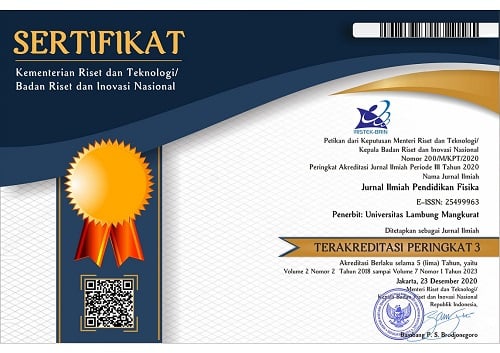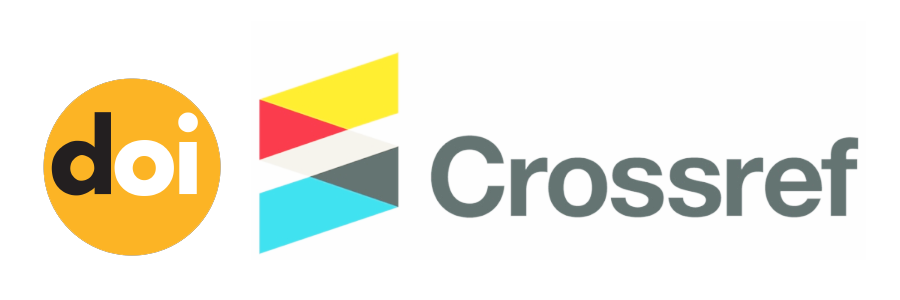Physics Student Misconception: Relative Velocity, Time Dilatation, and Length Contraction
Abstract
This study aims to analyze senior high school students' misconceptions on the relativity topics of relative velocity, time dilation, and length contraction. The qualitative descriptive method was used in this study to explain student misconceptions from the student, documents, and observations during problem-solving. Six students take an extra course in an independent learning center to participate in this study. The student was classified as two high, middle, and low levels. The data was collected from student reports, interviews, and observations. The results show a considerable misconception of students' understanding of relativity topics. This study identifies that student misconceptions come from the learning process, resources, and teacher confirmation. Thus, there is a need for attention and remediation regarding the relativity material because it will affect the concept of students to the next level.
Keywords
Full Text:
PDFReferences
Brown, D. E. (1992). Using examples and analogies to remediate misconceptions in physics: Factors influencing conceptual change. Journal of Research in Science Teaching, 29(1), 17–34.
Byrne, M. (2001). Interviewing as a data collection method. AORN Journal, 74(2), 233–234.
Chiriacescu, B., Chiriacescu, F., Miron, C., Barna, V., & Berlic, C. (2019). Whiteboard Animation–A Way to Ease the Understanding of Special Theory for the Relativity Principles Consequences. The 14th International Conference on Virtual Learning ICVL, 1(1), 512–518.
Creswell, J. W., & Poth, C. N. (2016). Qualitative inquiry and research design: Choosing among five approaches. Sage publications.
Devers, K. J., & Frankel, R. M. (2000). Study design in qualitative research--2: Sampling and data collection strategies. Education for Health, 13(2), 263.
Febrianti, J., Akhsan, H., & Muslim, M. (2019). Analisis miskonsepsi suhu dan kalor pada siswa sma negeri 3 tanjung raja. Jurnal Inovasi Dan Pembelajaran Fisika, 6(1), 90–102.
Fuentes, S. Q., Bloom, M., & Peace, H. (2014). Preservice elementary teachers' perspectives about the roles of conceptual understanding and factual/procedural knowledge in learning and teaching mathematics and science. Journal of Mathematics Education at
Teachers College, 5(1).
Hidayatulloh, M., Humairoh, F., Wachidah, U., Iswati, D. A., & Suliyanah, S. (2015). Pengembangan Perangkat Pembelajaran Untuk Mereduksi Miskonsepsi Siswa Pada Materi Rangkaian Listrik Dengan Scientific Approach. Jurnal Penelitian Fisika Dan Aplikasinya (JPFA), 5(1), 28–32. https://doi.org/10.26740/jpfa.v5n1.p28-32
Holloway, I., & Wheeler, S. (1996). Qualitative research for nurses. Blackwell Science Oxford.
Jusniar, J., Effendy, E., Budiasih, E., & Sutrisno, S. (2020). Misconceptions in Rate of Reaction and Their Impact on Misconceptions in Chemical Equilibrium. European Journal of Educational Research, 9(4), 1405–1423.
Li, Z. (2008). Special relativity arises from a misunderstanding of experimental results on the constant speed of light. Physics Essays, 21(2), 96–102.
Mabile, R. W. (2019). Misconceptions in Special Relativity–An Argument for Augmentation of the Modern Physics Course. Florida Southern College.
Master-Khodabakhsh, C. (2020). An alternative to special relativity: How a flawed experiment and misunderstanding of the fundamental laws of physics diverted physicists from their logical path. Physics Essays, 33(1), 79–84.
Mintzes, J. J., Wandersee, J. H., & Novak, J. D. (2001). Assessing understanding of biology. Journal of Biological Education, 35(3), 118–124.
Moylan, P. (2022). Velocity reciprocity and the relativity principle. American Journal of Physics, 90(2), 126–134.
Prado, X., Domínguez, J. M., Area, I., Edelstein, J., Mira, J., & Paredes, Á. (2020). Learning and teaching Einstein's Theory of Special Relativity: state of the art. ArXiv Preprint ArXiv:2012.15149.
Sarwadi, H. R. H., & Shahrill, M. (2014). Understanding students' mathematical errors and misconceptions: The case of year 11 repeating students. Mathematics Education Trends and Research, 2014(2014), 1–10.
Suparno, P. (2013). Miskonsepsi & perubahan konsep dalam pendidikan fisika. Gramedia Widiasarana.
Thurmond, V. A. (2001). The point of triangulation. Journal of Nursing Scholarship, 33(3), 253–258.
Treagust, D. F. (2006). Diagnostic assessment in science as a means to improving teaching, learning, and retention. Proceedings of The Australian Conference on Science and Mathematics Education.
DOI: https://doi.org/10.20527/jipf.v6i2.5258
Refbacks
- There are currently no refbacks.
Indexed by: Jurnal Ilmiah Pendidikan Fisika is licensed under a creative commons attribution-share alike 4.0 international license
Statistics Counter |
















